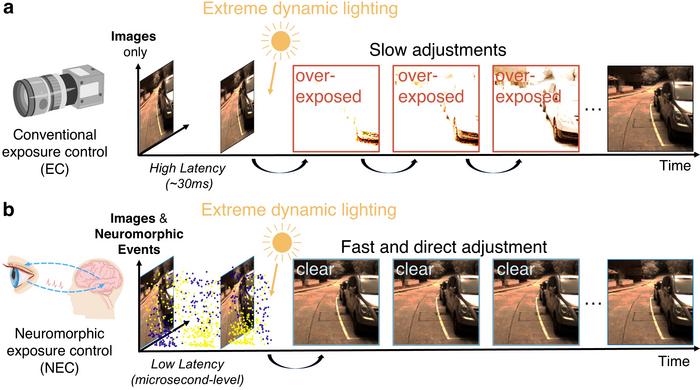
A recent groundbreaking achievement in machine vision emerged from a collaborative effort led by scientists from the University of Hong Kong (HKU) and the Australian National University. This innovative development focuses on a neuromorphic exposure control system dubbed NEC, which promises to redefine how machines perceive their environment amid fluctuating lighting conditions. The team’s research, published in the acclaimed journal Nature Communications, showcases a system that parallels human peripheral vision, offering remarkable speed and reliability across diverse applications.
At the core of this advancement lies the integration of event cameras, sophisticated sensors designed to capture per-pixel brightness changes as discrete events rather than full frames. This technological leap addresses a significant challenge faced by traditional automatic exposure systems that rely on feedback loops, which can struggle and fail during rapid shifts in brightness—an issue prevalent in environments like tunnels, where lighting conditions radically change in an instant. The NEC system effectively circumvents these limitations by utilizing a novel algorithm known as the Trilinear Event Double Integral (TEDI), demonstrating an operational capability of 130 million events per second on standard CPU hardware.
This innovative system mimics the biological mechanisms of the human eye, facilitating immediate adaptation to varied lighting conditions similar to how our pupils respond to changes in ambient light. Lead researcher Mr. Shijie Lin articulated this comparison, stating that the NEC system embodies a synergy reminiscent of the retinal pathways in biological organisms. By fusing event-driven data with physical light metrics, they have effectively bypassed traditional bottlenecks, creating a system capable of functioning optimally regardless of the lighting environment.
Empirical tests have validated the NEC system’s capabilities across multiple critical applications. For instance, in autonomous driving scenarios, the NEC system exhibited a substantial enhancement in detection accuracy during transitions from dark tunnels into glaring sunlight, achieving an impressive increase in mAP performance by 47.3%. This level of improvement addresses a crucial safety concern in vehicular automation, where milliseconds can determine the outcome of real-world driving situations.
The realm of Augmented Reality (AR) also benefits from this inventive technology, as evidenced by a reported 11% enhancement in pose estimation during hand-tracking exercises under surgical lighting. This advancement is particularly significant for medical professionals relying on precision and clarity in their augmented visual fields during operations, where any disruption could have serious implications for patient outcomes.
The NEC system indeed holds promise for revolutionary changes in 3D reconstruction processes. In environments characterized by excessive brightness, conventional methods often falter, but the NEC’s architecture is designed to enable continuous SLAM (Simultaneous Localization and Mapping) operations in such circumstances. This capability is foundational for various emerging technologies that rely on accurate environmental mapping and interpretation.
Medical applications extend beyond AR assistance, as the NEC system guarantees uninterrupted visualization even in dynamic lighting conditions that frequently change in operating theatres. This consistent clarity allows surgeons to maintain focus and precision, enhancing the safety and effectiveness of intricate procedures conducted under intensive light manipulation.
The researchers behind NEC have emphasized its significance, with Professor Jia Pan noting that this technological innovation not only elevates machine vision capabilities but also establishes a new paradigm that bridges biological principles with computational prowess. The NEC system highlights a shift from traditional methods, paving the way for advanced, adaptable, and resilient vision systems applicable in real-world settings such as autonomous vehicles and robotic medical devices.
According to Professor Evan Y. Peng, the collaborative research undertaken at HKU embodies the potential of interdisciplinary initiatives. By melding bio-inspired algorithms with event-based sensing approaches, they have created a vision system that not only enhances performance but excels under challenging environmental conditions. Their work serves as a testament to the impact of combining distinctive scientific disciplines to confront a diversity of complex challenges in engineering.
Looking toward the future, the NEC framework introduces a new model for processing high-resolution events and images which simultaneously decreases the computational burden associated with such tasks. Integrating biologically plausible mechanisms into the low-level controls of machine vision systems illustrates a transformative direction for camera design, system control, and subsequent algorithm development.
The implications of this research extend far beyond academia, hinting at substantial economic and practical benefits for various industries stemming from the integration of neuromorphic principles into optical and imaging technology. Companies focusing on robotics, health care, automotive technology, and potentially numerous other domains stand to gain significant advantages through the adoption of these novel methodologies in machine vision.
In conclusion, the NEC system epitomizes a revolutionary advancement in how machines interpret complex visual environments. As this technology finds its way into practical applications, it stands poised to redefine standards of innovation in fields spanning from autonomous transportation all the way to intricate surgical interventions. With its extraordinary adaptability and efficiency, NEC represents a monumental leap toward achieving truly intelligent vision systems capable of navigating the multifaceted challenges posed by real-world conditions.
Subject of Research: Neuromorphic exposure control (NEC) for machine vision
Article Title: Embodied neuromorphic synergy for lighting-robust machine vision to see in extreme bright
News Publication Date: 30-Dec-2024
Web References: 10.1038/s41467-024-54789-8
References: Nature Communications
Image Credits: The University of Hong Kong
Keywords
Neuromorphic, Machine Vision, Autonomous Driving, Augmented Reality, Medical Robotics, Event Cameras, Trilinear Event Double Integral Algorithm, Computational Imaging.
Tags: automatic exposure system challengesevent cameras integrationHKU research achievementsinnovative sensor technologylighting condition adaptationmachine vision technologyNature Communications publicationneuromorphic engineering applicationsneuromorphic exposure controlperipheral vision mimicryrapid brightness changesTrilinear Event Double Integral algorithm





